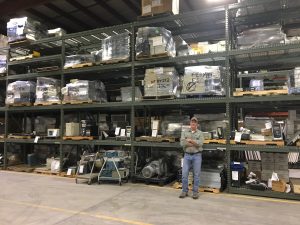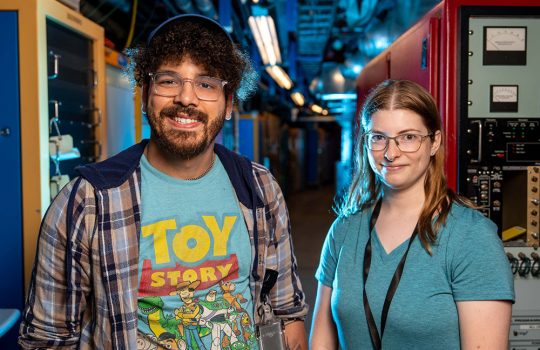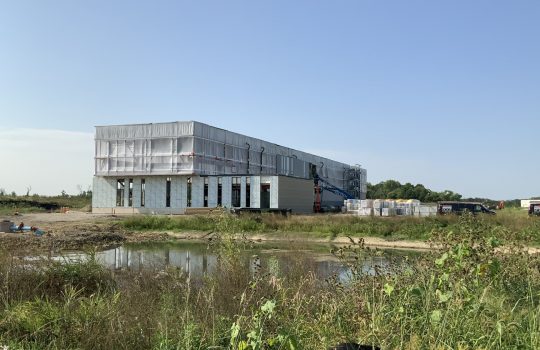
Fermilab’s Scott Borton stands in front of shelves full of old scientific equipment. Many of these items will be put to future use through the Laboratory Equipment Donation Program. Photo: Dan Garisto
If you’re a scientist looking for a bargain on a UV lamp source, CompuFlow thermo-anemometer, miscellaneous fiber optic components or an oscilloscope, Fermilab has you covered.
At the lab’s Warehouse No. 2, racks piled high with items stretch into the distance. When equipment at Fermilab is no longer needed, it’s picked up and stored here, where much of it is processed and sent to schools, universities and government agencies who request it.
The whole operation is run by Scott Borton, who oversees three separate initiatives at Fermilab: Computers for Learning, the Federal Disposal System and the Laboratory Equipment Donation Program (LEDP). Between 2015 and 2017, the total value of assets donated through all three programs was over $3,000,000.
For Fermilab, it’s a great way to extend the life of equipment that’s come to the end of its usefulness for the laboratory. And for prospective buyers, it’s hard to imagine a better deal.
“This is all free. They pay for shipping and that’s it,” Borton said.
Designed to reduce waste and provide opportunities for schools, labs and agencies lacking the funds, the programs are well-used at Fermilab, with items sent to Borton on a regular basis.
Fermilab employees send to the warehouse old or underused equipment that they no longer need. Plenty of items come through the warehouse, so it’s not always clear what the status of this equipment is.
“In a lot of the cases, the equipment’s been moved and transferred so often that nobody has any idea if it works or not,” Borton said.
When this happens, Borton and his staff often draw on the experience of Fermilab’s experts to determine the status of equipment to make sure it’s in working condition.
Although the equipment is used, the zero on the price tag is enticing for physics professors such as Raul Armendariz, who teaches at Queensborough Community College in New York City. Armendariz learned about LEDP and arranged for the equipment transfer through Fermilab’s QuarkNet program.
“Getting the laboratory equipment is so important,” Armendariz said. “It allows us to build detectors and create projects for students and have them take part in the learning community.”
In December, Armendariz used the nationwide LEDP program to purchase — at no cost — 1,800 pounds of plastic scintillator scavenged from Fermilab’s CDF detector, which was decommissioned in 2013. He plans to use the scintillator to set up a cosmic ray array at local high schools and colleges in New York City.
“We’re at a community college and we don’t have big money for this kind of stuff — that’s why the LEDP is crucial for us,” Armendariz said.
For Borton, recycling what was once state-of-the-art equipment to schools and other labs is just another day at work.
“At least the stuff isn’t going to scrap,” he said. “It’s being reused somewhere.”



